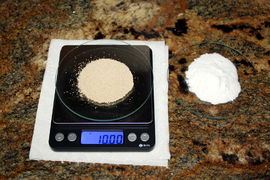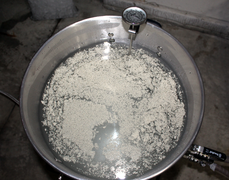Remove dissolved oxygen from water
|
Water naturally contains dissolved oxygen gas (abbreviated DO), and the amount can vary depending on the temperature, pressure, and other factors. Dissolved oxygen in the brewing water is a major source of oxygen during traditional mashing, where it totally overwhelmes the natural antioxidants in the malt.[1] In order to avoid damage to the mash components by oxidation, it's critical to remove the DO from the water before mash-in, a process called deaeration.[2][3][4][5][6][7] It's recommended to reduce the DO content of strike water to below 0.1 mg/L.[2] There are a couple different methods to accomplish this task, including options for any size of brewery.[8][9] Be aware that water deaeration is just part of a low oxygen brewing method — other steps must also be taken throughout the brewing process in order to successfully avoid oxidation.
Yeast for deaeration[edit]
Yeast cells rapidly consume dissolved oxygen,[10] which means that water can be deaerated in only 20–30 minutes just by adding some yeast and sugar; no advanced equipment is needed.[11][12] This is referred to as Yeast Oxygen Scavenging (YOS) among home brewers. Since the yeast cannot survive at standard mash-in temperatures, deaeration must be completed prior to heating the water to strike temperature. At 100°F (38°C), the yeast will rehydrate and deaerate the fastest, although yeast deaeration can be conducted at room temperature in a similar timeframe by using double the amounts of yeast and sugar. Thanks to the yeast, the water will actually remain deaerated for a few days, so it can be prepared overnight to save time on brew day. Although not necessary, a DO meter can be useful to verify that the water is deaerated before heating to strike temperature. This deaeration method appears not to have any negative effects on the wort or beer, as long as the as water is heated to a recommended strike temperature.[13] Interestingly, yeast has a direct antioxidant effect, even after cell death.[14][15] Therefore, the benefit of yeast in the strike water might even extend beyond simply removing DO.
Recommended procedure:
- Bring the water to around 100°F (38°C) and remove from the heat.
- For each US gallon, add 1 gram of active dry yeast and 1 gram of sugar (0.25 g/L of each). Dextrose (corn sugar) is the preferred sugar.
- Allow the yeast to rehydrate for around 5 minutes, and then stir gently.
- Add a cap to the water and wait at least 25 minutes.
-
Measure the yeast and sugar
-
Add them to the water
Boiling for deaeration[edit]
Oxygen has very low solubility in boiling water.[12][16] This means that boiling the strike water is a simple means to deaerate it before mash-in, although perhaps not the most effective.[17][12][11][18][19] This method requires high energy usage.
Procedure:
- Bring the water to a rolling boil for 10–15 minutes.
- Apply a cap to prevent oxygen from diffusing back into the water from the air.
- Rapidly chill to strike temperature and then proceed to mash-in as soon as possible.
Other deaeration methods[edit]
Sulfite (e.g. a metabisulfite product) can be used for deaeration since it reacts with dissolved oxygen.[20][21][18][22] However, this method is not preferred because the large amount of sulfite require to remove DO has a significant effect on the water mineral profile by adding substantial amounts of sulfate and either sodium or potassium.
Larger scale breweries can essentially deaerate water on demand by using advanced equipment like a dearation column or a membrane system. In a column system for example, hot water flows down through a pipe while either nitrogen or carbon dioxide gas bubbles up through it, stripping the DO, as per Henry's law.
See also[edit]
References[edit]
- ↑ Chapon L, Chemardin M. The dissolving and oxidation of malt tannoids on mashing-in. Proceedings from the Annual meeting of American Society of Brewing Chemists. 1964;22(1):244–258.
- ↑ a b Kunze W. Hendel O, ed. Technology Brewing & Malting. 6th ed. VLB Berlin; 2019.
- ↑ Narziss L, Back W, Gastl M, Zarnkow M. Abriss der Bierbrauerei. 8th ed. Weinheim, Germany: Wiley-VCH Verlag GmbH & Co. KGaA; 2017.
- ↑ Ditrych M, Filipowska W, De Rouck G, et al. Investigating the evolution of free staling aldehydes throughout the wort production process. BrewingScience. 2019;72(Jan/Feb):10–17.
- ↑ Taylor DG. Water. In: Stewart GG, Russell I, Anstruther A, eds. Handbook of Brewing. 3rd ed. CRC Press; 2017.
- ↑ Kanauchi M, Bamforth CW. A Challenge in the study of flavour instability. BrewingScience - Monatsschrift Brauwiss. 2018;71(Sept/Oct):82–84.
- ↑ Muller R. Use of 5,5’-dithiobis (2-nitrobenzoic acid) as a measure of oxidation during mashing. J Am Soc Brew Chem. 1995;53(2):53–58.
- ↑ Four of the best ways to deaerate your brewing water, depending on your budget. ProBrewer website. 2021. Accessed online April 2024.
- ↑ Dorton JK. Producing deaerated water: Methods, design considerations and operational implications. Slides presented at: Master Brewers Association of the Americas. Austin, Texas. October 2013. Accessed online April 2024.
- ↑ Nielsen H. The control of oxygen in beer processing. J Inst Brew. 1973;79(2):147–154.
- ↑ a b Rabe B. Deoxygenation revisited. The Modern Brewhouse website. 2020.
- ↑ a b c Alternate methods for oxygen scavenging mash water. German Brewing website. 2016.
- ↑ Choosing a malt mill. The Modern Brewhouse website. 2019. Accessed online April 2024.
- ↑ Comuzzo P, Toniolo R, Battistutta F, Lizee M, Svigelj R, Zironi R. Oxidative behavior of (+)‐catechin in the presence of inactive dry yeasts: a comparison with sulfur dioxide, ascorbic acid and glutathione. J Sci Food Agric. 2017;97(15):5158–5167.
- ↑ Comuzzo P, Battistutta F, Vendrame M, Páez MS, Luisi G, Zironi R. Antioxidant properties of different products and additives in white wine. Food chem. 2015;168:107–114.
- ↑ Solubility of air in water. The Engineering ToolBox website. 2004. Accessed online April 2024.
- ↑ Butler IB, Schoonen MA, Rickard DT. Removal of dissolved oxygen from water: A comparison of four common techniques. Talanta. 1994;41(2):211–215.
- ↑ a b Briggs DE, Boulton CA, Brookes PA, Stevens R. Brewing Science and Practice. Woodhead Publishing Limited and CRC Press LLC; 2004.
- ↑ Stephenson WH, Biawa JP, Miracle RE, Bamforth CW. Laboratory-scale studies of the impact of oxygen on mashing. J Inst Brew. 2003;109(3):273–283.
- ↑ Rodgers SJ. The reaction rate of sodium sulfite with dissolved oxygen. Technical Report No. 73. MSA Research Corp., Callery, PA.; 1960.
- ↑ Zupanovich JD. Oxidation and degradation products of common oxygen scavengers. The Analyst. 2002(Fall):1–8.
- ↑ How to remove oxygen from boiler feed water. ChemREADY website. 2023. Accessed online April 2024.


